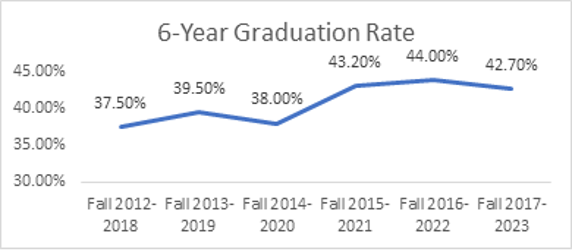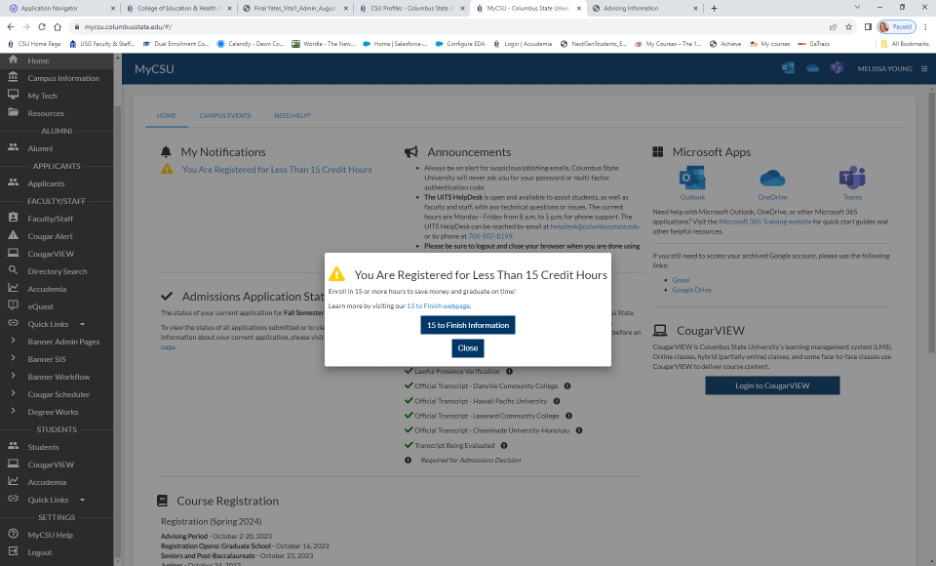Strengths with respect to student success
For 2022-23, we identified three student success activities in which we were striving to excel:
- structuring at least 3 HIPS into each baccalaureate program,
- encouraging a growth Mindset in students, and
- enhancing the co-curricular experience.
Of these, we are having the greatest success and making the most progress with the last one, enhancing the co-curricular experience, which encompasses a variety of activities:
- 15-to-Finish
- ROAR Orientation
- Program Maps for every major (See Appendix III: Continuing and Expanding Existing Momentum Work)
- Academic Focus Areas (See Appendix III: Continuing and Expanding Existing Momentum Work)
- Pressure Testing of Program Maps (See Appendix IV: Pressure Testing Program Maps Against Actual Course Offerings)
- Posting of 2-Year Rotation Schedule (disrupted; see 3.2, p. 14)
- Academic Milestones within majors
- Career Milestones within majors
In addition, CSU’s 6-year institutional graduation rate has increased by 5.2% in 5 years from 37.5% to 42.7%.
The following chart illustrates that, until COVID hit in March 2020, CSU had decreased the number of full-time freshmen (FTF) enrolled in fewer than 24 credits (blue bar) and increased the number of students enrolled in 24-30+ hours (orange and gray bars). This was largely due to a registration process that defaulted new students into a full 15-hour schedule. In 2022-2023, the blue bar (less than 24 credit hours) is again declining after increasing dramatically at the start of the pandemic.
CSU has posted several 15-to-finish videos in the ROAR 1000 orientation D2L course. These cover the importance of staying on pace to graduate, what to do to catch up, how course load and satisfactory academic progress affect financial aid, and tips specific to transfer students.
In Fall 2023, CSU ADVISE worked with UITS to develop an alert that is posted on the MyCSU page of any undergraduate student enrolled in fewer than 15 hours, which provides students with encouragement to add hours and links to an informational page detailing why 15-to-Finish is so important:
CSU also established a dedicated advisor for all transfer students to aid in their transition and review of applicable credit, part of Collaborative Transfer Unit with Enrollment Management, Registrar, Student Life, and CSU ADVISE.
Priority areas for continued improvement
Some of our 2022-2023 plans had to be delayed since the institution’s focus during the Summer and Fall semesters was directed toward Strategic Alignment of Resources, institutional accreditation matters, and other priorities that emerged. The intended HIPs project was partly stalled by Strategic Alignment activity and temporary personnel shifts. We partially completed our Mindset plans by incorporating Mindset training in the training activities of tutors and peer coaches. We also incorporated workshopping for Mindset in Cougar Launch and Cougar Scholars. We are in the process of designing a Mindset measure that we hope to implement in Spring 2024, one that will supplement the system measure and provide us with meaningful data on all our students, not just our freshmen.
The Co-curricular Experience objectives were largely implemented, except for the 2-year course schedule rotation. Course scheduling was partly disrupted since we were discussing a revision of our academic calendar to eliminate the January term. Course rotations were also modified as inefficiencies were addressed through the Strategic Alignment process.
Mindset:
- Draw data from and revise questions in ROAR 1000 and assess regularly to monitor trends.
- Develop some Mindset videos for inclusion in ROAR 1000.
- Incorporate Mindset interventions in Cougar Scholars & Cougar Launch. (completed)
Design for HIPs:
- Complete the 10-program pilot analyses.
- Develop a department self-assessment tool to gauge the extent to which 3 or more course HIP experiences are part of their program design for all students.
- Redo website after its loss when a faculty member’s google account was deleted.
- Implement badging
- Orchestrate themed events
Pathways for Student Success:
- Improve the collection of student participation data at campus events; need to track their engagement either through scanning of their IDs or through an app. Cost comparisons are needed.
- Relocate program maps for advising purposes (due to the departure of EAB).
- Leverage the Strategic Alignment reporting to identify and remove curricular barriers to student progression. (Role for Curricular Analytics?)
- Expand and assess Cougar Scholars and Cougar Launch programs.
Observations and Next Steps
Goal Setting:
|
Area |
Time period/Time from now |
Goal |
|
Enrollment & Diversity |
Ongoing-annually |
We are a very diverse campus in many areas to include age, student type, military affiliations, and race/ethnic background.
Increase non-traditional student populations to address approaching enrollment cliff related to the number of graduating HS seniors. |
|
Retention & Retention gaps |
Ongoing-annually |
Our retention rate had been increasing prior to COVID, and took a dip 20-21 down to 59.6% from 74.5% the year prior. Last year (2022), we rose to 65.4%, and in 2023 changed to 72.2%. Our hope is to continue to raise our retention rates annually, with a goal of 80%. |
|
Graduation & Graduation gaps |
Ongoing-annually |
Our graduation rates have increased over the years. We plan to continue striving to see continued increases, with a goal of 60%. |
|
Completion of Area A courses in the first year |
Ongoing-annually |
Our goal is that all students complete Area A in the first year. 61% of students complete Area A ENGL and MATH courses in their first year with 65% passing their two ENGL courses. |
|
Credit Intensity for full time students and closing disparities |
Ongoing-annually |
This goal highlights a 15-to-finish marketing campaign, student videos in ROAR (orientation), text campaigns to students enrolled in fewer than 15 hrs. We’d like to increase the number of students taking 15 or more hours across all classifications. This project has been assigned to the Faculty Senate Academic Advising Committee for further development. |
Where would you like to see student success move in the year(s) ahead?
We continue to strive for excellence and have set aspirational student achievement goals of 80% retention of FTFT students, and 60% six-year graduation rate.
CSU partnered with the National Institute of Student Success in September 2023. The NISS Team and CSU Project Leads are currently reviewing diagnostic data and developing recommendations to present to administration and the campus at large. Their recommendations will be complete around February 2024. This work will inform our next steps in fostering a community committed to the success of our students.
In addition, we're implementing the IMPACTS core curriculum in two stages and hope for a more significant, student-success driven version starting Fall 2025.
What supports from the System Office would be most helpful in advancing your work?
The System Office would be most helpful if it could provide information that would assist us in NISS items, including implementing evidence-based programs, data driven student support, equity gap reduction, and predictive analytics.




